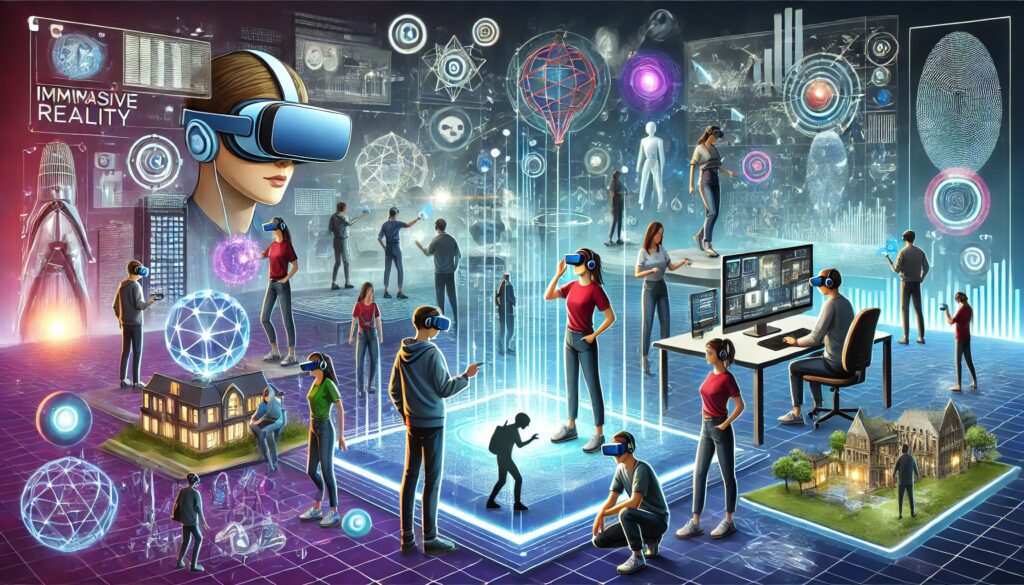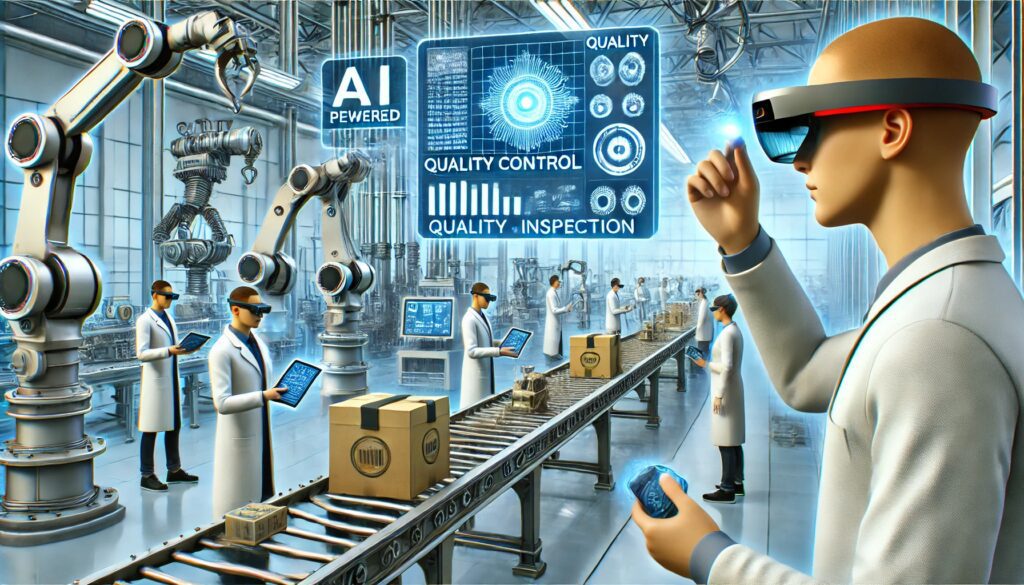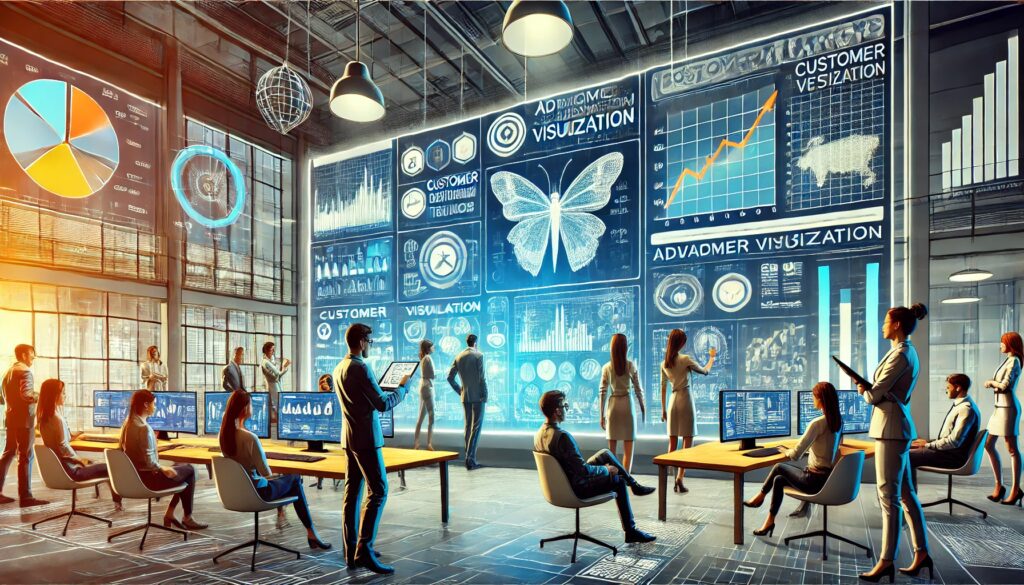
Revolutionizing Manufacturing: Immersive Reality Tech
1. Training and Simulation
Immersive reality technologies like virtual reality (VR) and augmented reality (AR) are revolutionizing training environments in manufacturing. These cutting-edge tools offer lifelike simulations and interactive experiences that greatly enhance the learning process. Consequently, they are transforming the way workers are trained.
Benefits
- Reduces need for physical prototypes: Virtual models replace physical prototypes, saving costs and allowing quicker iterations. Additionally, this streamlines the development process.
- Minimizes training costs: Immersive training methods reduce material and logistic expenses, cutting training time by up to 75% (PwC, StartUs Insights). Therefore, companies can train employees more efficiently.
- Enhances safety by simulating hazardous conditions: Workers can safely experience and respond to hazardous situations, improving real-world safety protocols (Bernard Marr, StartUs Insights). As a result, the workplace becomes much safer.
Implementation
- VR Headsets for Immersive Hands-On Training: Workers use VR headsets for detailed, realistic training sessions. These headsets provide a comprehensive understanding of machinery and processes without the risk of real-world practice. Consequently, trainees develop their skills more effectively.
- AR Overlays for On-The-Job Guidance: AR technology overlays crucial information and instructions directly onto a worker’s field of view, enhancing accuracy and efficiency during tasks. For instance, AR can guide a technician through complex repair processes in real-time, reducing errors and improving productivity (PwC, Bernard Marr).
- Interactive Simulations for Skill Assessments: Interactive simulations provide detailed skill assessments, offering immediate feedback and enabling workers to refine their skills in a controlled environment. These simulations cover a wide range of scenarios, from basic operational tasks to emergency response drills (MobiDev, StartUs Insights). Therefore, workers are better prepared for any situation.
Examples
- Simulating Machinery Operation: VR creates immersive simulations of machinery operations, allowing users to interact with complex equipment safely. This is valuable in manufacturing, construction, and aviation, where hands-on experience is essential but often risky.
- Training in Emergency Response Scenarios: VR simulates a wide range of emergency scenarios, providing a realistic and immersive training experience. Consequently, trainees can engage in lifelike emergencies, improving their preparedness and decision-making skills.
- Virtual Onboarding for New Employees: VR enhances the onboarding process by providing interactive and engaging experiences. New hires can explore the office, engage in role-specific training, and connect with the company’s culture virtually before their first day. Therefore, they start their job better prepared and more engaged.

2. Remote Assistance
Augmented reality (AR) is transforming remote assistance, allowing experts to provide real-time, visual support to on-site technicians. This approach significantly improves the efficiency and effectiveness of maintenance and repair operations.
Benefits:
- Improves repair and maintenance efficiency: AR enables experts to guide technicians through complex procedures, ensuring tasks are performed correctly the first time. Thus, reducing errors.
- Reduces downtime by providing instant support: Immediate expert assistance minimizes equipment downtime, increasing overall productivity. Consequently, operations run more smoothly.
- Cuts travel costs and response time: By providing remote support, companies can avoid the expenses and delays associated with sending experts to the site. Therefore, saving both time and money.
Implementation:
- AR Glasses with Live Video Feed: Technicians equipped with AR glasses share their field of view with remote experts. This allows experts to provide precise, real-time instructions and annotations, facilitating accurate and immediate guidance.
- AR Overlays for Step-by-Step Instructions: AR technology overlays step-by-step repair instructions directly onto the technician’s field of view, enhancing the accuracy and efficiency of the repair process.
- Real-Time Annotations and Guidance: Remote experts can provide real-time annotations and guidance on the technician’s display. This interactive support allows quick corrections and adjustments, ensuring high-quality repairs.
Examples:
- Remote Diagnostics and Troubleshooting: AR enables experts to diagnose and troubleshoot issues remotely, reducing the need for on-site visits and speeding up the repair process.
- Maintenance Support for Complex Machinery: Technicians receive real-time guidance for maintaining and repairing complex machinery, ensuring tasks are completed accurately and efficiently.
- Instant Feedback and Supervision During Critical Repairs: AR allows experts to monitor critical repairs in real-time, providing immediate feedback and ensuring high-quality workmanship.

3. Design and Planning
Virtual reality (VR) is enhancing design and planning in manufacturing by enabling virtual walkthroughs and collaborative planning. Teams can visualize and interact with factory layouts, product designs, and planning scenarios in a virtual environment, improving overall decision-making and efficiency.
Benefits:
- Enhances collaborative decision-making: VR facilitates real-time collaboration, enabling team members to make informed decisions together.
- Identifies design flaws early: Virtual simulations help spot potential issues before physical implementation, saving time and resources. Thus, preventing costly mistakes.
- Reduces physical mock-up costs: By creating virtual prototypes, companies can avoid the high costs associated with physical mock-ups and iterations. Consequently, the development process becomes more cost-effective.
Implementation:
- VR Simulations of Factory Layouts: Use VR simulations to design and optimize factory layouts. Teams can walk through the virtual factory, test different configurations, and identify potential bottlenecks or inefficiencies.
- Virtual Prototyping for New Products: Develop virtual prototypes of new products to evaluate design, functionality, and user experience. This allows for thorough testing and iteration before committing to physical production.
- Collaborative VR Meetings for Design Review: Conduct collaborative VR meetings where team members can gather in a virtual space to review designs, discuss changes, and make decisions. This immersive setting improves communication and understanding among team members.
Examples:
- Virtual Tours of New Factory Setups: Conduct virtual tours of proposed factory setups, allowing stakeholders to explore and provide feedback without the need for physical site visits.
- Immersive Product Design Sessions: Engage in immersive product design sessions where designers and engineers can interact with virtual models, test features, and make real-time adjustments.
- Space Planning and Optimization in a Virtual Environment: Use VR to plan and optimize space utilization in factories or warehouses, ensuring efficient use of available space and resources.

4. Quality Control and Inspection
Augmented reality (AR) is transforming quality control and inspection in manufacturing. By enhancing the accuracy, speed, and effectiveness of inspection processes, AR technology ensures higher product quality and consistency.
Benefits:
- Enhances accuracy and speed of inspections: AR overlays help inspectors identify defects and issues quickly and accurately.
- Provides instant feedback on product quality: Real-time data integration allows for immediate quality assessments, enabling quick corrective actions.
- Reduces manual inspection errors: Automated AR-guided inspections minimize human errors and ensure consistency in quality control.
Implementation:
- AR Devices for Overlaying Defect Detection Information: Use AR devices such as smart glasses or tablets to overlay defect detection information onto the physical products. This visual aid helps inspectors identify and document defects accurately and efficiently.
- Real-Time Data Integration for On-The-Spot Quality Checks: Integrate real-time data from various sensors and inspection tools into the AR system. This allows inspectors to access up-to-date information instantly, facilitating on-the-spot quality checks and decisions.
- Automated AR-Guided Inspection Routines: Develop automated AR-guided routines that standardize inspection processes. These routines guide inspectors through each step, ensuring comprehensive and consistent inspections across all products.
Examples:
- Inspecting Assembly Lines with AR Overlays Highlighting Defects: AR overlays can highlight defects on assembly lines, making it easier for inspectors to spot and address issues promptly.
- Verifying Product Specifications in Real-Time: AR can verify product specifications in real-time by comparing the physical product to digital models and standards.
- Automated Comparison of Products Against Standards Using AR: Automated AR systems can compare products against predefined standards, ensuring each item meets quality requirements before it moves to the next stage of production.

5. Customer Engagement and Visualization
Augmented reality (AR) and virtual reality (VR) are transforming customer interactions and visualizations in manufacturing. These technologies provide immersive and interactive experiences that improve customer understanding and satisfaction.
Benefits
- Improves customer understanding of complex products: AR and VR allow customers to see and interact with products in a detailed and comprehensive manner, making it easier to grasp complex features and functions.
- Enhances customer experience and satisfaction: Immersive experiences engage customers more deeply, leading to higher satisfaction and a stronger connection to the brand.
- Facilitates better customer feedback: By allowing customers to interact with virtual models, companies can gather more accurate and actionable feedback on product designs and features.
Implementation
- VR Demonstrations of Product Usage: Use VR demonstrations to showcase how products work in a realistic virtual environment. Customers can experience the product’s functionality and benefits firsthand, enhancing their understanding and interest.
- AR Apps for Visualizing Product Fit and Function in Real Environments: Develop AR apps that enable customers to visualize how products will fit and function in their own environments. This helps customers make informed purchasing decisions and increases their confidence in the product.
- Interactive VR Product Showcases: Create interactive VR showcases where customers can explore products in detail. These showcases can simulate various scenarios and use cases, providing a comprehensive understanding of the product’s capabilities.
Examples
- Virtual Showrooms for Customer Walkthroughs: Set up virtual showrooms where customers can take guided tours of different products and see them in action. This immersive experience can replicate the feel of a physical showroom.
- AR Applications for Customizing and Visualizing Products: Use AR apps to allow customers to customize products and see the changes in real-time. For example, customers can change colors, sizes, and features, and immediately see how the final product will look.
- Immersive Product Demos at Trade Shows and Exhibitions: Use VR and AR to create immersive product demos at trade shows and exhibitions. These demos attract attention and engage visitors, providing a memorable and informative experience.
Conclusion
AR and VR technologies are transforming customer engagement and visualization in the manufacturing industry. By improving understanding, enhancing experiences, and facilitating feedback, these technologies help companies build stronger relationships with their customers and drive better business outcomes (PwC, MobiDev, StartUs Insights).